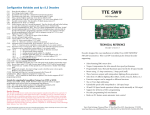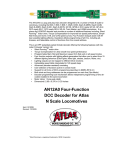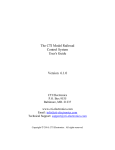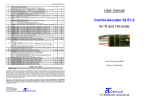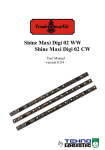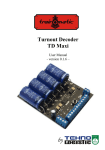Download TTE GP7 - Tony`s Train Exchange
Transcript
Configuration Variables used by v3.5 Decoders CV1 CV2 CV3 CV4 CV5 CV6 CV7 CV8 CV11 Short decoder address; 1-127 valid Start Voltage (useful range 0-100) Acceleration rate (each unit = 7mS between speed steps) 255 max. Deceleration rate (each unit = 7mS between speed steps) 255 max. Vmax, speed at highest speed step. 0=use factory default of 255 Vmid, speed (on a scale of 1-255) at speed step 7,14,or 63. 0=use default of 127 Decoder version number. This decoder is 35 which means version 3.5 Manufacturer ID. NCE = 11 (0B hex) Packet timeout value (in ½ second increments) Time the decoder will wait before braking to a stop after running into a section of track with DC power. 0=Don’t brake CV15 Decoder programming lock “KEY”. This CV is always programmable even when “locked” CV16 Decoder programming lock ID. When CV15=CV16, programming is unlocked and the decoder will respond to programming commands. If CV15 is not equal to CV16 then decoder programming is locked and it will not program (except CV15) or read. CV17 High byte of long (4 digit) address - bit 6,7 always= 1; - bits 0-5 are upper 6 bits of address CV18 Low byte of long (4 digit) address CV19 Consist address. (0 or 128 = no consist active) - bits 0-6 short consist address (1-127 valid) - bit 7 0= direction is normal, 1= direction is reversed CV21 Functions active in consist mode. Bit 0 controls F1,bit 1=F2, bit 2=F3, etc. - bit 0 - 1=function can be controlled at consist address, 0 = no consist control CV22 Functions active in consist mode. Bits 0,1 control FLF and FLR respectively each bit 1=function can be controlled at consist address, 0 = no consist control CV29 - bit 0 1= direction of operation is reversed, 0= direction is normal - bit 1 1=28 speed mode (always enabled) - bit 2 1= analog operation mode enabled, 0 = disabled - bit 4 1= alternate speed table active, 0= use table defined by CV2, 5, 6 - bit 5 1= use long address in CV17/18, 0= use short address CV1 - bits 3,6,7 are ignored by the decoder CV30 Set this CV to 2 on the programming track and the decoder will reset to factory settings. CV33-CV39 function mapping CVs for F0-F5 CV67-CV94 Uploadable speed table steps 1-28 (128 speed mode calculates intermediate steps) CV95 Reverse trim, values 1-127 add to reverse speed, values 129-255 add to forward speed CV116 Torque kick rate - number of 16ms periods in a row that motor is ‘kicked’ with voltage pulse CV117 Torque kick strength - how much voltage is used to kick the motor at slow speeds. Reduces to 0 as speed is increased. CV118 Ditch light hold time (in ¼ second increments) after F2 goes off. CV120-CV124 Effects configuration registers for outputs 1-5 CV NOTES: All CV numbers not listed above may be programmed but not used by the decoder. This decoder supports all DCC programming methods. Formula for computing the long address if using a Lenz SET01 or SET02: If using a Lenz SET01, SET02, SET90, SET100 or other entry level system, use paged programming mode and see below for programming long addresses. CV17 = 192 + (the whole number portion of the long address divided by 256) CV18 = the remainder after the long address is divided by 256 CV29 = 34 if analog mode disabled, 38 if analog mode enabled Decoder Warranty This decoder is fully factory tested and warranted against manufacturing defects for a period of 1 year. As the circumstances under which this decoder is installed can not be controlled, failure of the decoder due to installation problems can not be warranted. This includes misuse, miswiring, operation under loads beyond the design range of the decoder or short circuits in the locomotive manufacturer’s factory wiring. If the decoder fails for non-warranted reasons NCE will replace the decoder, no questions asked, for $10 U.S. plus $2 shipping. For warranty or non-warranty replacement send the decoder (and any payment, if required) to: NCE Warranty Center, 899 Ridge Road, Webster, New York 14580 The terms Silent Running, Powerhouse Pro, Power Pro, SmartCab, ProCab, Switch-It, Snap-It, the NCE logo with “Power of DCC” slogan and EFX are trademarks of NCE Corporation. Digitrax is a trademark of Digitrax Inc. TTE GP7 HO Decoder TECHNICAL REFERENCE Decoder version 3.5 Decoder for easy installation in LifeLike HO Scale 0-8-0, GP7, GP9, GP30 and SD60 locomotives. This is an EPF (extended packet format) decoder supporting: • Silent Running(TM) motor drive • Torque Compensation for ultra smooth low speed performance • Programmable Start, Mid and Maximum speed works for all speed modes • Motor rating 1.3 Amp continuous, 2 Amp peak (stall) • Five function outputs each with independent lighting effects generators • Select from 15 different lighting effects (Mars, strobes, beacon, flicker, etc) • Lighting outputs can be mapped to different functions • Uploadable speed table interpolated to 128 speed steps • Decoder assisted consisting • Support for all forms of DCC programming • Decoder programming lock mechanism • Brake on DC feature assists automatic train control Tony’s Train Exchange, Pinewood Plaza, 57 River Road, Box 1023, Essex Junction, VT 05452 www.TonysTrains.com, [email protected], 800-978-3472 or 802-878-5005, FAX 802-878-5550 Rev. May 22, 2004 Installation Notes TTE GP7 HO Decoder Technical Reference Factory Default Values for Decoder Configuration Variables (CVs) In the GP7/GP9/30/SD60 remove the two screws holding the existing PC board, discard the PC board and replace it with the TTE-GP7 decoder. Do not use the two screws to mount the decoder. The body shell will center the decoder on the frame. Caution: to avoid short circuits place a piece of ELECTRICAL TAPE on the bottom of the decoder to insulate it from the locomotive frame. Also, make sure there are no pinched wires between the decoder and frame or between the decoder and connector pins. Headlights LifeLike uses 1.5 Volt bulbs without current limiting with their GP7, GP9, GP30 and SD60 locomotives. See the diagram to the right for lighting options. Recommended Lighting If you use LEDs we recommend a 1 kOhm 1/4 Watt series resistor in each function lead • Miniatronics #12-310-05 Yellow Glo White LEDs. • Richmond Controls (or equivalent) Golden White LEDs. • Miniatronics #18-712-10 (12V) or #18-014-10 (14V) incandescent bulbs Test the locomotive before replacing the body shell. Double check your wiring to make sure the motor is fully isolated and that there are no pinched or broken wires. We see many decoders returned due to wires getting pinched between the body shell and frame causing shorts. If the locomotive runs in the wrong direction on both DCC and DC, reverse Motor(+) and Motor(-) connections. If it runs in the wrong direction on DC only, reverse the Left and Right rail pickup connections (make sure you reverse wires on both ends of the decoder). Always test your decoder installation on an current limited programming track before trying it on full track power. Configuration of CV29 settings: Table of commonly used values for CV29 We recommend that the first full power testing be done on regular DC. If the track pickup polarity is reversed you will want to correct this for proper analog mode operation. The decoders should be driven by a good quality smooth DC power unit. Power packs with pulse power systems such as “tracking control” etc. will give unpredictable operation. DC Lighting This decoder remembers which functions are on or off between uses. If a function was on during DCC operation it will be on during DC operation. Lighting effects (Mars, flicker, etc) will also operate. Lighting effects work best in DC mode when used with LEDs. Hex numbers are provided for early Digitrax users Notes: • If you want to reverse the direction of travel on DCC increase the value for CV29 by one (this also reverses all directional lighting). • If you want to reverse the DC direction reverse the track pickup wires. Function Output Ratings Due to the high inrush current of incandescent grain-of-wheat type bulbs (about 10 times their normal 2 7 Rev. May 22, 2004 Description of function mapping CVs Function mapping can change which outputs are controlled by a function command from your handheld cab. It is possible to have one command control several outputs. In the table below each row corresponds to a function mapping CV and each column indicates an output number. The bold number in a column is the factory default. Programming the CV to the value under an output number will change that output to be controlled by that function number. In the table below the factory value of CV35 is 4 which means F1 will control Output #3. If you want F1 to control output 4 program CV35 to 8. If you want F1 to control both outputs 3 and 4 add the two values for those outputs together (4+8=12) and program CV35 with 12. Note in this decoder CV33 and CV34 operate identically. They are not directional ... directionality is provided in the EFX configuration CV for each output. Recommend dropping resistors if using 1.5 Volt bulbs. TTE GP7 HO Decoder Technical Reference operating current) function outputs are rated at 40 mA each if used with incandescent bulbs. We recommend the Miniatronics part number mentioned above. If you wish to use 50-100 mA rated lamps we recommend a 22 Ohm 1/4 Watt series resistor in function leads with each bulb (this will also greatly extend bulb life). Fine Tuning Locomotive Operation The factory settings normally provide good performance for most locomotives in HO scale. You may want to improve or fine tune performance by adjust the starting characteristics or top speed. There are 6 CVs that define: • The voltage at which the motor starts • How often and how hard the motor gets kicked a slow speeds to keep it turning smoothly. • The maximum motor speed • The mid speed range response characteristics or ‘speed curve’. • Compensation for a motor that runs faster in one direction Star oltage - CV2 (Vstar t): This is the amount of voltage sent to the motor when first starting up. We Startt V Voltage (Vstart): set CV2 so the locomotive is almost able to maintain movement at speed step 1. We then use CV116 and 117 to apply enough torque compensation to keep it turning on speed step 1. Typical values for CV2 are in the range of 0-35. Tor que compensation kick rate - CV116: How frequently the motor is ‘kicked’ at slow speed. Typical orque adjustment is 2 to 4. The smaller the number the more often the motor gets a brief voltage ‘kick’. Factory default is 0 (off). A value of 1 applies kicks continuously. The maximum practical value is about 6. Tor que compensation kick str ength - CV117: How hard the motor is ‘kicked’ at slow speed. Typical orque strength adjustment is 4 to 25. The larger the number the more voltage is applied in each ‘kick’. The strength of these kicks fade out ratiometrically as speed is increased providing a smooth transition to normal motor operation. Factory default is 0 (off), usable range 0-50. Vmax - CV5: If your locomotive runs too fast you can use CV5 to lower its maximum speed. Setting CV5 to 255 uses the maximum possible voltage to run the motor when full speed is requested. Set CV5 to a smaller value to reduce the top speed. A value of 128 will yield approximately ½ full voltage to the motor at top speed. 192 will provide about ¾ full voltage. All speeds from the middle speed step to the maximum will be proportionally reduced (see diagram). If CV5 is set to 0 the decoder will use 255 for maximum speed. Always make sure CV5 is greater than CV6 to avoid erratic operation. Vmid - CV6: CV6 determines how the motor responds through its middle speed ranges to advancement of the throttle. If you set CV6 lower than half the maximum speed you’ll have smaller increases in motor speed through the lower speed ranges. Then, as you hit the upper speed ranges there will be larger increases between speed steps. In the diagram below you can see this best illustrated by the ‘customized’ line. If you set Vstart larger than 0 you’ll will most likely want to raise Vmid so a reasonable slope is maintained in the ‘speed curve’. If CV6 is set to 0 the decoder will use 127 as the value. If you use high values in CV117 you will want to increase CV6 by a proportional amount to keep a smooth acceleration curve. 6 3 Rev. May 22, 2004 Reverse trim (also for war d trim) - CV95: Values from 1-127 make decoder run faster in reverse than forwar ward forward. 1 is one speed step faster in reverse, 2 is two steps faster, etc. Values from 129-255 make decoder run faster in forward than reverse. 129 is one speed step faster in forward, 130 is 2 speed steps faster, etc. 0 and 128 add nothing to either direction . Effects programming (and function mapping) examples TTE GP7 HO Decoder Technical Reference How to do it: • Output 1 is already activated by F0 (factory default setting of CV33 =1). • Configure output 1 as a standard output, on in both directions, yet dimmable when F4 is activated. Set CV120 to 32 (20 hex). You can optionally set CV120 to 36 if you want F8 to control the dimming instead of F4. • Configure the rear light to be on in reverse and off in forward operation: set CV121 to 2. Switcher: Ditch lights What we want to do: • Use outputs 3 and 4 for the left and right ditch lights • They will be controlled by F2 which is the HORN button on most DCC systems • They should continue flashing for 5 seconds after the HORN button is released How to do it: • Program outputs 3 and 4 to both be activated by F2. Set the F2 mapping CV (CV36) to 12. We get the value of 12 by adding the values for output 3 and output 4 on the F2 line of the CV mapping table on page 7. • Program outputs 3 and 4 for ditch light operation. Set CV122 to 56 and CV123 to 60. Using these values the lights will be qualified by the headlight AND function 2. The headlight must be on for the ditch lights to be activated by F2. Type 1 ditch lights are on constantly on when the headlight is on and alternately flash when the horn is blown. Type 2 ditch lights are normally off until the horn is blown. This example is for the more common Type 1. If you prefer Type 2 use EFX values 52 and 48 instead of 60 and 56. • CV118 sets the amount of time the ditch lights stay flashing after the horn (F2) is deactivated. The time is measured in 1/4 second intervals, for a hold time of 5 seconds put a value of 20 in the CV118. • One last thing: Set CV35 to 0 so output 3 is not also controlled by F1 Mars Light: What we want to do: • Use output 3 (marked A on decoder) for a Mars light • It is to be on in the forward direction only How to do it: • Output 3 is already activated by F1 (factory default setting of CV35=4). • Configure output 3 as a forward only Mars light. Set CV122 to 9. We get the value of 9 by using 8 (Mars Light) plus 1 (output operates only in forward direction). Rule 17 lighting: Rule 17 refers to how the locomotive engineer operates the locomotive headlights during the running of the train. The rule varies from road to road but generally requires the dimming of the headlight(s) when in a siding waiting to meet another train, passing through passenger stations or moving within yard limits. What we want to do: • Use output 1 for the Headlight • The headlight is to be on bright in both directions of locomotive travel • We also want to be able to dim the headlight • Use output 2 for the rear light. It is to come on in reverse, off in forward 4 What we want: • Headlights that dim in the opposite direction that the locomotive is travelling • Use output 1 as Headlight and output 2 as Rearlight How to do it: • Outputs 1 and 2 are already activated by F0 due to the factory default settings. • Configure output 1 as bright in forward, dim in reverse. Set CV120 to 44 (2C hex). • Configure output 2 as bright in reverse, dim in forward. Set CV121 to 40 (28 hex). Description of EFX configuration CVs CV120 - Lighting effect configuration for output 1 (headlight). CV121 - Lighting effect configuration for output 2 (rearlight). CV122 - Lighting effect configuration for output 3 (marked A on decoder). CV123 - Lighting effect configuration for output 4 (marked B on decoder). CV124 - Lighting effect configuration for output 5 (Solder “pad” on decoder). Each output wire can select from 15 different lighting effects by using its associated EFX configuration CV. Pick the value for the CV from the table below, add 1 or 2 if you want the effect to be directional (footnotes 2 and 3), then add 128 if you are using a white LED for the effect. Ditch lights should not be made directional, they’re not 1 - Functions are designed to use 1216 Volt 30-40 mA incandescent lamps. If you are using a white LED (with 1k limiting resistor) add 128 to the CV value. 2 - If you want the function to be active only in the reverse direction add 2 to the CV value 3 - If you want the function to be active only in the forward direction add 1 to the CV value 5




